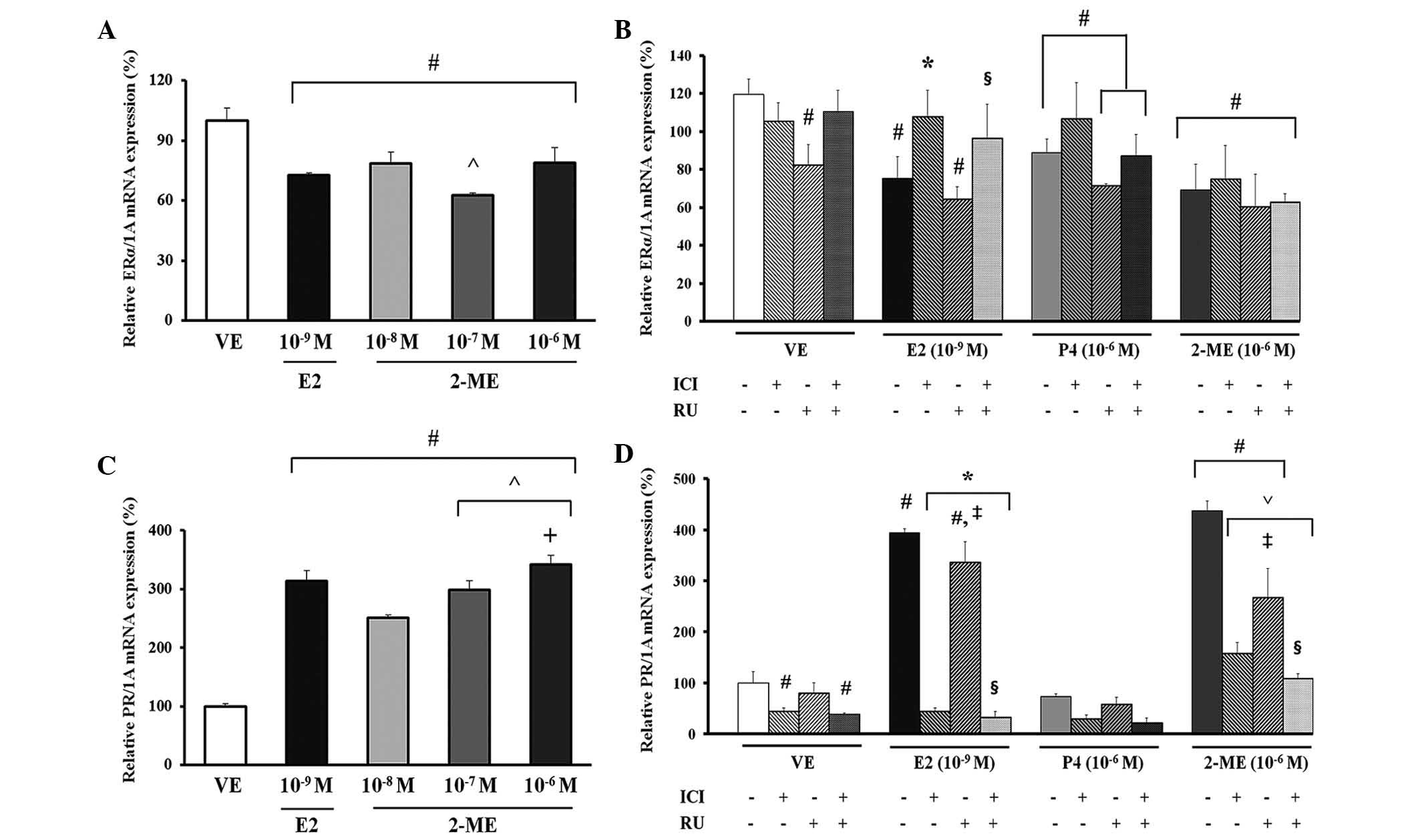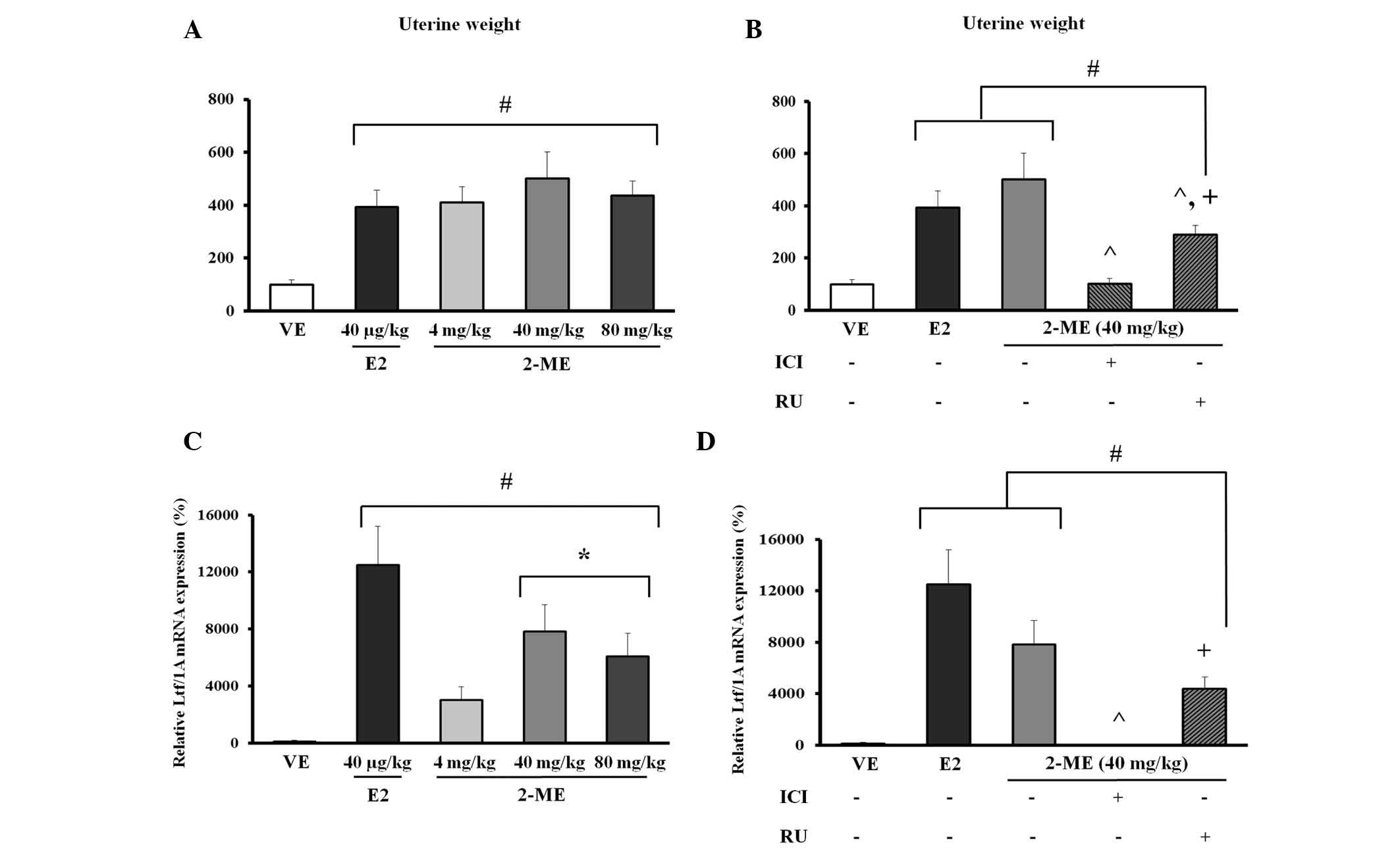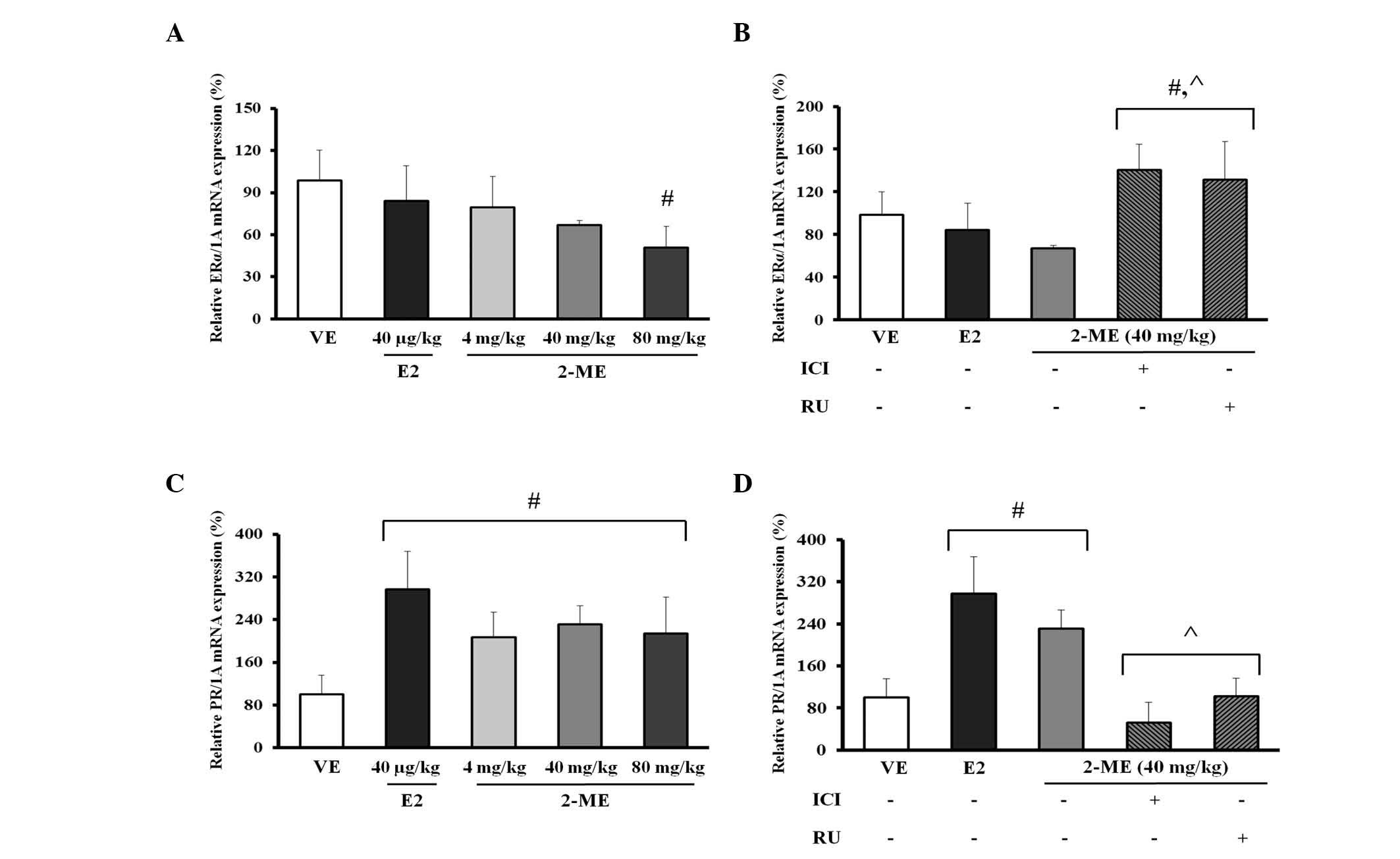|
1
|
Wang SH, Myc A, Koenig RJ, Bretz JD,
Arscott PL and Baker JR: 2-Methoxyestradiol, an endogenous estrogen
metabolite, induces thyroid cell apoptosis. Mol Cell Endocrinol.
165:163–172. 2000. View Article : Google Scholar : PubMed/NCBI
|
|
2
|
Männistö PT and Kaakkola S:
Catechol-O-methyltransferase (COMT): Biochemistry, molecular
biology, pharmacology, and clinical efficacy of the new selective
COMT inhibitors. Pharmacol Rev. 51:593–628. 1999.PubMed/NCBI
|
|
3
|
Zhang Y, Gaikwad NW, Olson K, Zahid M,
Cavalieri EL and Rogan EG: Cytochrome P450 isoforms catalyze
formation of catechol estrogen quinones that react with DNA.
Metabolism. 56:887–894. 2007. View Article : Google Scholar : PubMed/NCBI
|
|
4
|
Spady TJ, McComb RD and Shull JD: Estrogen
action in the regulation of cell proliferation, cell survival, and
tumorigenesis in the rat anterior pituitary gland. Endocrine.
11:217–233. 1999. View Article : Google Scholar
|
|
5
|
Pribluda VS, Gubish ER Jr, Lavallee TM,
Treston A, Swartz GM and Green SJ: 2-Methoxyestradiol: An
endogenous antiangiogenic and antiproliferative drug candidate.
Cancer Metastasis Rev. 19:173–179. 2000. View Article : Google Scholar
|
|
6
|
Hamel E, Lin CM, Flynn E and D'Amato RJ:
Interactions of 2-methoxyestradiol, an endogenous mammalian
metabolite, with unpolymerized tubulin and with tubulin polymers.
Biochemistry. 35:1304–1310. 1996. View Article : Google Scholar : PubMed/NCBI
|
|
7
|
Banerjeei SK, Zoubine MN, Sarkar DK,
Weston AP, Shah JH and Campbell DR: 2-Methoxyestradiol blocks
estrogen-induced rat pituitary tumor growth and tumor angiogenesis:
Possible role of vascular endothelial growth factor. Anticancer
Res. 20:2641–2645. 2000.PubMed/NCBI
|
|
8
|
D'Amato RJ, Lin CM, Flynn E, Folkman J and
Hamel E: 2-Methoxyestradiol, an endogenous mammalian metabolite,
inhibits tubulin polymerization by interacting at the colchicine
site. Proc Natl Acad Sci USA. 91:3964–3968. 1994. View Article : Google Scholar : PubMed/NCBI
|
|
9
|
Attalla H, Westberg JA, Andersson LC,
Adlercreutz H and Mäkelä TP: 2-Methoxyestradiol-induced
phosphorylation of Bcl-2: Uncoupling from JNK/SAPK activation.
Biochem Biophys Res Commun. 247:616–619. 1998. View Article : Google Scholar : PubMed/NCBI
|
|
10
|
Chang I, Majid S, Saini S, Zaman MS,
Yamamura S, Chiyomaru T, Shahryari V, Fukuhara S, Deng G, Dahiya R,
et al: Hrk mediates 2-methoxyestradiol-induced mitochondrial
apoptotic signaling in prostate cancer cells. Mol Cancer Ther.
12:1049–1059. 2013. View Article : Google Scholar : PubMed/NCBI
|
|
11
|
Farhat GN, Parimi N, Chlebowski RT, Manson
JE, Anderson G, Huang AJ, Vittinghoff E, Lee JS, Lacroix AZ, Cauley
JA, et al: Sex hormone levels and risk of breast cancer with
estrogen plus progestin. J Natl Cancer Inst. 105:1496–1503. 2013.
View Article : Google Scholar : PubMed/NCBI
|
|
12
|
Yue W, Yager JD, Wang JP, Jupe ER and
Santen RJ: Estrogen receptor-dependent and independent mechanisms
of breast cancer carcinogenesis. Steroids. 78:161–170. 2013.
View Article : Google Scholar
|
|
13
|
Gökmen-Polar Y, Escuin D, Walls CD, Soule
SE, Wang Y, Sanders KL, Lavallee TM, Wang M, Guenther BD,
Giannakakou P, et al: Beta-Tubulin mutations are associated with
resistance to 2-methoxyestradiol in MDA-MB-435 cancer cells. Cancer
Res. 65:9406–9414. 2005. View Article : Google Scholar : PubMed/NCBI
|
|
14
|
Zhu BT and Conney AH: Is
2-methoxyestradiol an endogenous estrogen metabolite that inhibits
mammary carcinogenesis? Cancer Res. 58:2269–2277. 1998.PubMed/NCBI
|
|
15
|
Brueggemeier RW and Singh U: Inhibition of
rat liver microsomal estrogen 2-hydroxylase by 2-methoxyestrogens.
J Steroid Biochem. 33:589–593. 1989. View Article : Google Scholar : PubMed/NCBI
|
|
16
|
Tinnanooru P, Dang VH, Nguyen TH, Lee GS,
Choi KC and Jeung EB: Estrogen regulates the localization and
expression of calbindin-D9k in the pituitary gland of immature male
rats via the ERalpha-pathway. Mol Cell Endocrinol. 285:26–33. 2008.
View Article : Google Scholar : PubMed/NCBI
|
|
17
|
Lee GS, Choi KC, Park SM, An BS, Cho MC
and Jeung EB: Expression of human Calbindin-D (9k) correlated with
age, vitamin D receptor and blood calcium level in the
gastrointestinal tissues. Clin Biochem. 36:255–261. 2003.
View Article : Google Scholar : PubMed/NCBI
|
|
18
|
Dang VH, Nguyen TH, Choi KC and Jeung EB:
A calcium-binding protein, calbindin-D9k, is regulated through an
estrogen-receptor mediated mechanism following xenoestrogen
exposure in the GH3 cell line. Toxicol Sci. 98:408–415. 2007.
View Article : Google Scholar : PubMed/NCBI
|
|
19
|
Hong EJ, Park SH, Choi KC, Leung PC and
Jeung EB: Identification of estrogen-regulated genes by microarray
analysis of the uterus of immature rats exposed to endocrine
disrupting chemicals. Reprod Biol Endocrinol. 4:492006. View Article : Google Scholar : PubMed/NCBI
|
|
20
|
Walmer DK, Wrona MA, Hughes CL and Nelson
KG: Lactoferrin expression in the mouse reproductive tract during
the natural estrous cycle: Correlation with circulating estradiol
and progesterone. Endocrinology. 131:1458–1466. 1992.PubMed/NCBI
|
|
21
|
Newbold RR, Teng CT, Beckman WC Jr,
Jefferson WN, Hanson RB, Miller JV and McLachlan JA: Fluctuations
of lactoferrin protein and messenger ribonucleic acid in the
reproductive tract of the mouse during the estrous cycle. Biol
Reprod. 47:903–915. 1992. View Article : Google Scholar : PubMed/NCBI
|
|
22
|
Fujimoto N, Jinno N and Kitamura S:
Activation of estrogen response element dependent transcription by
thyroid hormone with increase in estrogen receptor levels in a rat
pituitary cell line, GH3. J Endocrinol. 181:77–83. 2004. View Article : Google Scholar : PubMed/NCBI
|
|
23
|
Banerjee SN, Sengupta K, Banerjee S,
Saxena NK and Banerjee SK: 2-Methoxyestradiol exhibits a biphasic
effect on VEGF-A in tumor cells and upregulation is mediated
through ER-alpha: A possible signaling pathway associated with the
impact of 2-ME2 on proliferative cells. Neoplasia. 5:417–426. 2003.
View Article : Google Scholar : PubMed/NCBI
|
|
24
|
Yang H, Nguyen TT, An BS, Choi KC and
Jeung EB: Synergistic effects of parabens on the induction of
calbindin-D (9k) gene expression act via a progesterone
receptor-mediated pathway in GH3 cells. Hum Exp Toxicol.
31:134–144. 2012. View Article : Google Scholar
|
|
25
|
Vo TT, An BS, Yang H, Jung EM, Hwang I and
Jeung EB: Calbindin-D9k as a sensitive molecular biomarker for
evaluating the synergistic impact of estrogenic chemicals on GH3
rat pituitary cells. Int J Mol Med. 30:1233–1240. 2012.PubMed/NCBI
|
|
26
|
Jung EM, An BS, Choi KC and Jeung EB:
Potential estrogenic activity of triclosan in the uterus of
immature rats and rat pituitary GH3 cells. Toxicol Lett.
208:142–148. 2012. View Article : Google Scholar
|
|
27
|
Vo TT, Jung EM, Choi KC, Yu FH and Jeung
EB: Estrogen receptor α is involved in the induction of Calbindin-D
(9k) and progesterone receptor by parabens in GH3 cells: A
biomarker gene for screening xenoestrogens. Steroids. 76:675–681.
2011. View Article : Google Scholar : PubMed/NCBI
|
|
28
|
Ahn HJ, Yang H, An BS, Choi KC and Jeung
EB: Expression and regulation of Enpp2 in rat uterus during the
estrous cycle. J Vet Sci. 12:379–385. 2011. View Article : Google Scholar : PubMed/NCBI
|
|
29
|
Wang Y, Tu Y, Han F, Xu Z and Wang J:
Developmental gene expression of lactoferrin and effect of dietary
iron on gene regulation of lactoferrin in mouse mammary gland. J
Dairy Sci. 88:2065–2071. 2005. View Article : Google Scholar : PubMed/NCBI
|
|
30
|
Fotsis T, Zhang Y, Pepper MS, Adlercreutz
H, Montesano R, Nawroth PP and Schweigerer L: The endogenous
oestrogen metabolite 2-methoxyoestradiol inhibits angiogenesis and
suppresses tumour growth. Nature. 368:237–239. 1994. View Article : Google Scholar : PubMed/NCBI
|
|
31
|
Krisinger J, Setoyama T and Leung PC:
Expression of calbindin-D9k in the early pregnant rat uterus:
Effects of RU 486 and correlation to estrogen receptor mRNA. Mol
Cell Endocrinol. 102:15–22. 1994. View Article : Google Scholar : PubMed/NCBI
|
|
32
|
Krisinger J, Dann JL, Currie WD, Jeung EB
and Leung PC: Calbindin-D9k mRNA is tightly regulated during the
estrous cycle in the rat uterus. Mol Cell Endocrinol. 86:119–123.
1992. View Article : Google Scholar : PubMed/NCBI
|
|
33
|
Sibonga JD, Lotinun S, Evans GL, Pribluda
VS, Green SJ and Turner RT: Dose-response effects of
2-methoxyestradiol on estrogen target tissues in the ovariectomized
rat. Endocrinology. 144:785–792. 2003. View Article : Google Scholar : PubMed/NCBI
|
|
34
|
Williams K, McKinnell C, Saunders PT,
Walker M, Fisher JS, Turner KJ, Atanassova N and Sharpe M: Neonatal
exposure to potent and environmental oestrogens and abnormalities
of the male reproductive system in the rat: Evidence for importance
of the androgenoestrogen balance and assessment of the relevance to
man. Hum Reprod Update. 7:236–247. 2001. View Article : Google Scholar : PubMed/NCBI
|
|
35
|
Swedenborg E, Pongratz I and Gustafsson
JA: Endocrine disruptors targeting ERbeta function. Int J Androl.
33:288–297. 2010. View Article : Google Scholar : PubMed/NCBI
|
|
36
|
Keightley MC: Steroid receptor isoforms:
Exception or rule? Mol Cell Endocrinol. 137:1–5. 1998. View Article : Google Scholar : PubMed/NCBI
|
|
37
|
Mangelsdorf DJ, Thummel C, Beato M,
Herrlich P, Schütz G, Umesono K, Blumberg B, Kastner P, Mark M,
Chambon P, et al: The nuclear receptor superfamily: The second
decade. Cell. 83:835–839. 1995. View Article : Google Scholar : PubMed/NCBI
|
|
38
|
Akbas GE, Fei X and Taylor HS: Regulation
of HOXA10 expression by phytoestrogens. Am J Physiol Endocrinol
Metab. 292:E435–E442. 2007. View Article : Google Scholar
|
|
39
|
Kim YR, Jung EM, Choi KC and Jeung EB:
Synergistic effects of octylphenol and isobutyl paraben on the
expression of calbindin-D (9)k in GH3 rat pituitary cells. Int J
Mol Med. 29:294–302. 2012.
|
|
40
|
Mooberry SL: New insights into
2-methoxyestradiol, a promising antiangiogenic and antitumor agent.
Curr Opin Oncol. 15:425–430. 2003. View Article : Google Scholar : PubMed/NCBI
|
|
41
|
Browder T, Butterfield CE, Kräling BM, Shi
B, Marshall B, O'Reilly MS and Folkman J: Antiangiogenic scheduling
of chemotherapy improves efficacy against experimental
drug-resistant cancer. Cancer Res. 60:1878–1886. 2000.PubMed/NCBI
|
|
42
|
Liu ZJ and Zhu BT: Concentration-dependent
mitogenic and antiproliferative actions of 2-methoxyestradiol in
estrogen receptor-positive human breast cancer cells. J Steroid
Biochem Mol Biol. 88:265–275. 2004. View Article : Google Scholar : PubMed/NCBI
|
|
43
|
Turner RT and Evans GL: 2-Methoxyestradiol
inhibits longitudinal bone growth in normal female rats. Calcif
Tissue Int. 66:465–469. 2000. View Article : Google Scholar : PubMed/NCBI
|
|
44
|
Takanashi K, Honma T, Kashiwagi T, Honjo H
and Yoshizawa I: Detection and measurement of urinary
2-hydroxyestradiol 17-sulfate, a potential placental antioxidant
during pregnancy. Clin Chem. 46:373–378. 2000.PubMed/NCBI
|
|
45
|
Ireson CR, Chander SK, Purohit A, Perera
S, Newman SP, Parish D, Leese MP, Smith AC, Potter BV and Reed MJ:
Pharmacokinetics and efficacy of 2-methoxyoestradiol and
2-methoxyoestradiol-bis-sulphamate in vivo in rodents. Br J Cancer.
90:932–937. 2004. View Article : Google Scholar : PubMed/NCBI
|













